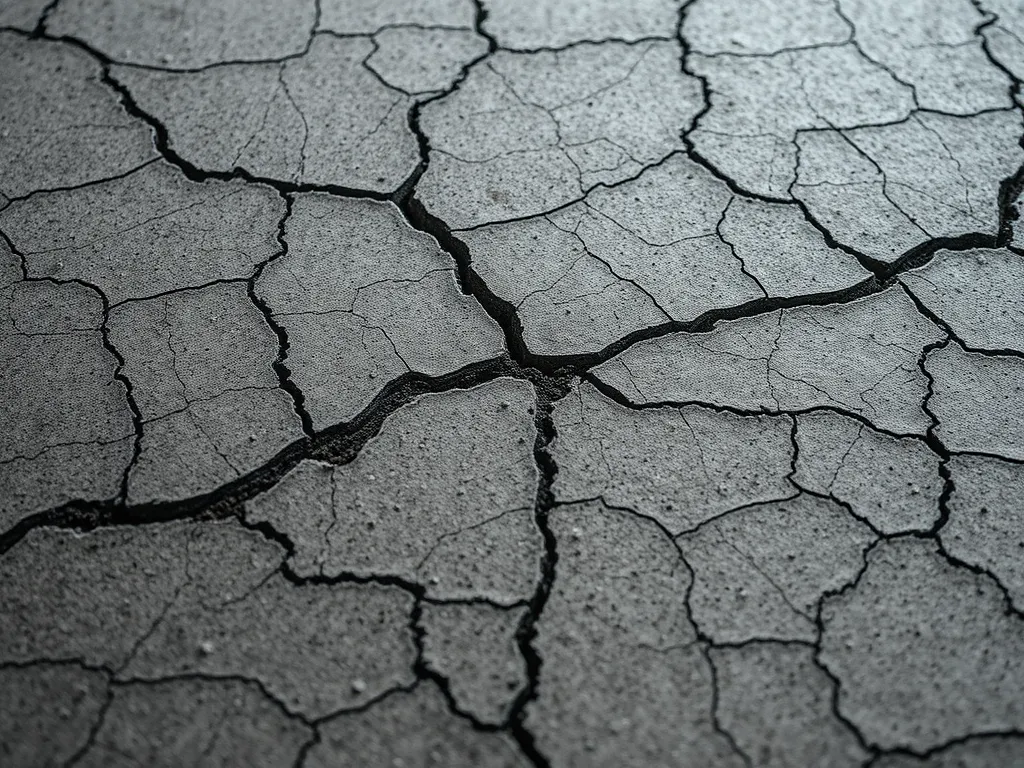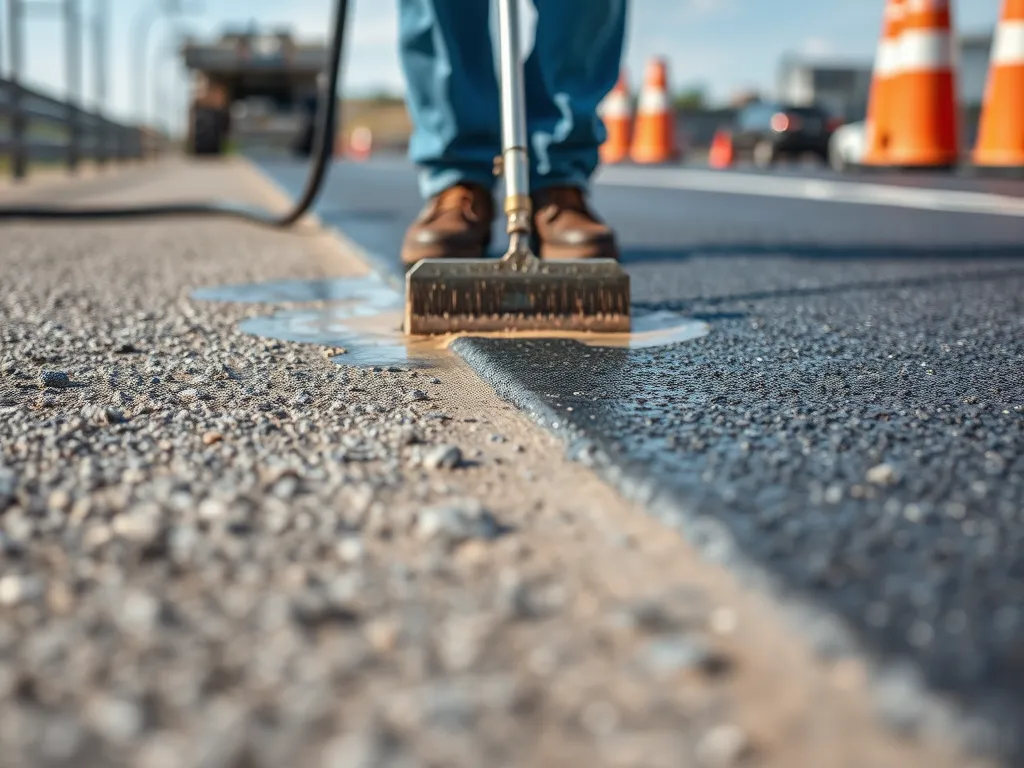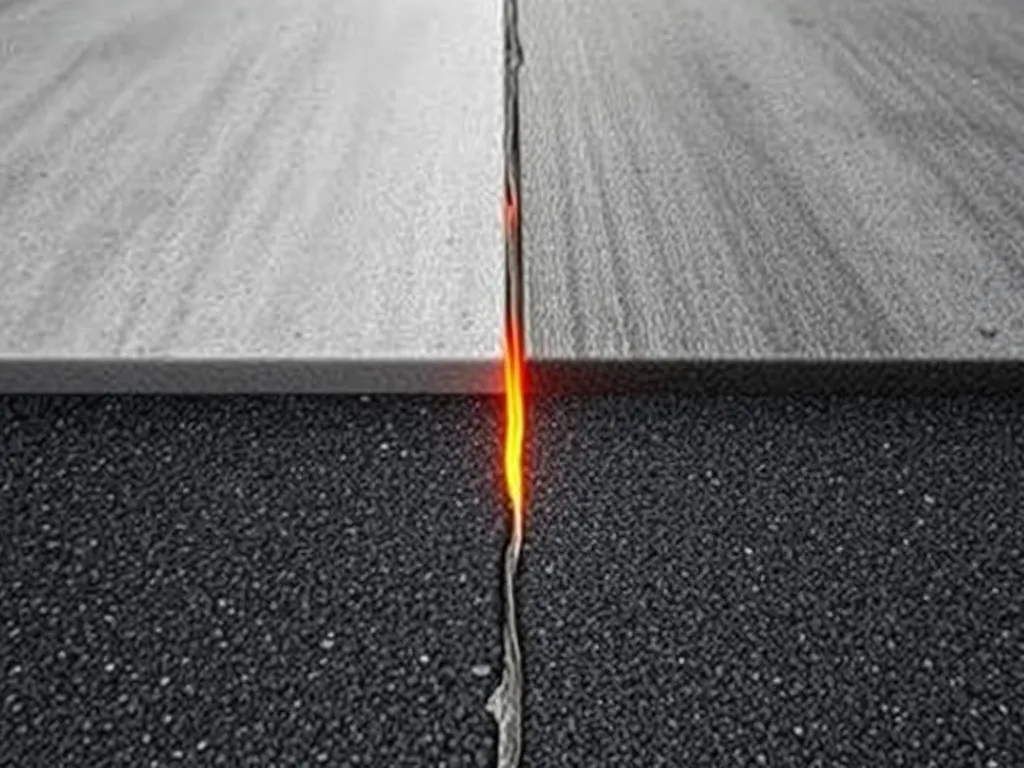Asphalt Vs Concrete Maintenance: Costs, Care, and Longevity Compared
Published on: August 10, 2025 | Last Updated: April 14, 2025
Written By: George Voss
Asphalt and concrete maintenance differ in cost, process, and long-term value. Asphalt requires sealcoating every 3-5 years to prevent cracks and costs $0.15-$0.25 per square foot, while concrete needs less frequent sealing but faces pricier repairs ($3-$5 per square foot for resurfacing). Asphalt’s flexible bitumen base adapts to temperature shifts but may crack faster; concrete’s rigid cement structure resists wear longer but can spall in freeze-thaw cycles. Both materials demand regular inspections, but asphalt repairs are quicker and 30-40% cheaper on average.
This guide examines asphalt and concrete upkeep side-by-side. We’ll break down material science basics, repair methods like crack filling vs. slab jacking, and budget factors over 10+ years. You’ll see real-world data on lifespan extensions (15-20 years for asphalt vs. 20-40 years for concrete) and environmental impacts. Safety traits like asphalt’s heat absorption (120°F+ in summer) and concrete’s reflective surfaces get explored. By the end, you’ll know which material suits your climate, traffic needs, and wallet.
Contents
- Key Differences Between Asphalt and Concrete Maintenance
- Asphalt Vs Concrete Maintenance Processes
- Cost Comparison: Asphalt Vs Concrete Upkeep
- Durability and Lifespan: Asphalt Vs Concrete
- Repair Methods for Asphalt Vs. Concrete
- Pros and Cons Of Asphalt Vs Concrete
- Environmental Impact Of Asphalt Vs Concrete Maintenance
- Safety Considerations in Asphalt Vs Concrete Maintenance
- FAQs: Asphalt Vs Concrete Maintenance
- Closing Thoughts
- Additional Resources for You:
Key Differences Between Asphalt and Concrete Maintenance
Maintaining asphalt and concrete surfaces requires distinct approaches due to their unique properties. Let’s break down how material science shapes upkeep strategies.
Material Composition and Maintenance Needs
Asphalt contains bitumen (a petroleum-based binder) mixed with aggregates, creating a flexible surface. Concrete uses cement paste binding sand/gravel, forming rigid slabs. These formulas dictate maintenance schedules: asphalt needs sealcoating every 2-5 years, while concrete requires less frequent but more complex repairs.
Asphalt Flexibility vs. Concrete Rigidity
Asphalt’s elasticity allows slight bending under weight, preventing immediate cracks from minor shifts. This flexibility demands regular crack sealing to stop water intrusion. Concrete’s stiffness resists bending but cracks under soil movement or freeze-thaw cycles. Repairs often involve full-depth replacement of damaged sections.
| Factor | Asphalt | Concrete |
|---|---|---|
| Thermal Expansion | Expands/contracts without cracking | Prone to thermal contraction cracks |
| Repair Speed | 24-hour cure for patches | 7-day concrete curing period |
| Surface Renewal | Sealcoating ($0.14-$0.25/sq ft) | Grinding/Resurfacing ($3-$10/sq ft) |
How Weather Affects Asphalt vs. Concrete Surfaces
UV radiation oxidizes asphalt binders, causing brittleness over time. Sealcoating blocks 80% of UV damage. Concrete resists UV but suffers from deicing salts – chloride ions corrode rebar in reinforced slabs. In freeze zones, asphalt handles 30+ freeze-thaw cycles before cracking; concrete may spall after 15 cycles without proper air-entrainment additives.
Temperature extremes play different roles. Asphalt softens at 140°F, risking rutting from heavy loads. Concrete maintains strength up to 750°F but loses 50% of durability below -20°F. Both materials need joint maintenance: asphalt edges require backfill to prevent crumbling, while concrete control joints need sealants to block water.
These material behaviors set the stage for evaluating specific maintenance processes. Next, we’ll examine routine care steps for each pavement type.
Asphalt Vs Concrete Maintenance Processes
Proper upkeep varies dramatically between asphalt and concrete surfaces. Each material demands unique strategies to preserve structural integrity and appearance.
Routine Asphalt Maintenance Steps
Asphalt requires proactive care to combat wear from traffic and weather. Key tasks focus on sealing and repairing surface flaws.
Sealcoating Frequency and Benefits
Sealcoating protects asphalt every 3-5 years. This $0.15-$0.25 per square foot treatment blocks UV rays, water intrusion, and chemical spills. Fresh sealants restore the rich black finish while adding 2-3 years to pavement life.
Asphalt Crack Filling and Patching
Fill cracks wider than 1/4 inch using rubberized asphalt or cold-pour compounds. For potholes, infrared patching blends new material with existing pavement at $50-$200 per repair. Ignoring cracks leads to base failures requiring full-depth replacements costing $3-$5 per square foot.
Concrete Maintenance Requirements
Concrete needs less frequent but more intensive interventions. Stains and cracks mar its appearance faster than asphalt, demanding specialized fixes.
Cleaning and Stain Removal for Concrete
Pressure wash concrete annually at 2,500-3,000 PSI to remove oil stains or mildew. Acid-based cleaners (pH 3-4) dissolve efflorescence but require protective gear. Unsealed concrete absorbs spills rapidly, making prompt cleaning critical.
Concrete Crack Repair Techniques
Hairline cracks under 1/8 inch use epoxy injections. Larger fractures need routing (widening cracks) before applying silicone or polyurethane sealants. Unlike asphalt’s flexible patches, rigid concrete repairs average $4-$8 per linear foot and may leave visible seams.
Surface care directly impacts long-term costs and performance. Next, let’s break down how these processes affect your budget over time.

Cost Comparison: Asphalt Vs Concrete Upkeep
Owners must weigh both upfront spending and recurring costs when selecting pavement materials. Maintenance expenses differ sharply between these options over time.
Initial Installation Vs. Long-term Maintenance Costs
Asphalt installation runs $2–$5 per square foot versus concrete’s $4–$15 range. Yet yearly upkeep for asphalt consumes 25–40% more budget due to frequent treatments. Concrete requires fewer interventions but faces pricier fixes when damage occurs. Over 20 years, total costs often balance: $9–$12/sq ft for asphalt versus $10–$14 for concrete.
Budgeting for Asphalt Repairs Vs. Concrete Repairs
Plan $0.50–$2.50/sq ft yearly for asphalt upkeep including crack filling. Concrete needs $0.30–$1.50 annually but spikes to $8–$12/sq ft for slab replacements. Key factors:
- Asphalt pothole repair: $50–$300 per incident
- Concrete joint resealing: $1–$3 per linear foot
- Full-depth concrete repair: $20–$30/sq ft
Cost of Sealcoating vs. Concrete Resurfacing
Sealcoating costs $0.15–$0.25/sq ft every 3–5 years. Concrete resurfacing runs $3–$5/sq ft every 10–15 years. While resurfacing lasts longer, its upfront cost equals 12–20 years of asphalt sealing. Freeze-thaw regions see higher concrete expenses due to spalling repairs at $4–$8/sq ft.
Beyond dollars, consider how climate impacts material performance. Next, we’ll explore durability factors in extreme weather conditions.
Also See: Effective Sealing Products for Asphalt Driveways
Durability and Lifespan: Asphalt Vs Concrete
Material longevity directly impacts maintenance schedules and costs. Asphalt typically lasts 15-25 years, while concrete can endure 30-40 years with proper care. These ranges depend on climate, traffic loads, and maintenance quality.
Average Lifespan Of Asphalt Vs. Concrete Pavement
New asphalt pavements last 15-25 years before requiring full replacement. Concrete surfaces often reach 30-40 years. Both materials degrade faster in extreme weather zones. For example, freeze-thaw cycles accelerate wear on both surfaces.
How Maintenance Extends Asphalt Longevity
Sealcoating every 2-5 years adds 5-8 years to asphalt’s lifespan. Crack filling prevents water infiltration – a leading cause of base layer erosion. Infrared patching fixes localized damage at $3-$7 per square foot. Overlays ($2.50-$4 per sq.ft.) refresh surfaces without full reconstruction.
- Polymer-modified sealants protect against UV oxidation
- Drainage systems reduce water pooling risks
- Routine inspections catch raveling early
Concrete Degradation Over Time
Concrete suffers from spalling (surface flaking) and scaling within 10-15 years if unsealed. Joint sealant failures allow water intrusion, causing frost heave in cold climates. Alkali-silica reaction (ASR) creates map-like cracks in 20% of untreated slabs. Maintenance includes:
- Pressure washing ($0.15-$0.35 per sq.ft.) to remove deicing salts
- Diamond grinding ($2-$5 per sq.ft.) for surface leveling
- Epoxy injections ($10-$30 per linear foot) for structural cracks
While concrete lasts longer initially, repair complexity increases costs over time. Next, we examine specific repair methods for both materials.

Repair Methods for Asphalt Vs. Concrete
Surface repairs differ significantly between asphalt and concrete due to material properties. Asphalt requires frequent but localized fixes, while concrete often demands more intensive restoration once damage occurs.
Addressing Asphalt Surface Damage
Asphalt’s flexibility allows targeted repairs for cracks, potholes, and raveling. Quick action prevents water infiltration, which can weaken the base layers. Most fixes use hot mix asphalt or cold patch materials.
Pothole Repair in Asphalt
Potholes form when water erodes the subbase under asphalt layers. Repair crews clean debris, apply tack coat adhesive, and fill the hole with hot mix asphalt (300°F–350°F). Compaction with plate compactors ensures adhesion. Costs range $50–$200 per pothole, depending on depth and location.
Fixing Common Concrete Issues
Concrete repairs focus on structural integrity and surface aesthetics. Cracks wider than 1/4 inch require epoxy injections or routing-and-sealing. Spalling and scaling often signal deeper deterioration from freeze-thaw cycles or salt exposure.
Managing Concrete Spalling and Scaling
Spalling occurs when surface layers flake off due to corrosion of embedded rebar or salt damage. Workers chip away damaged areas, apply bonding agents, and patch with polymer-modified concrete. Severe cases may require full-depth replacement at $8–$12 per sq.ft. Resurfacing with a 2-inch overlay costs $3–$5 per sq.ft.
| Repair Type | Asphalt | Concrete |
|---|---|---|
| Common Issue | Potholes | Spalling |
| Typical Cost | $50–$200 per hole | $8–$12 per sq.ft. |
| Time to Complete | 2–4 hours | 24–48 hours |
Material choices also impact repair durability. Asphalt patches blend with existing pavement, while concrete repairs often show visible seams.
Up next: We break down the pros and cons of each material’s maintenance demands.
Pros and Cons Of Asphalt Vs Concrete
Selecting between these materials requires balancing short-term benefits with long-term upkeep demands. Maintenance needs differ due to their physical properties, weather responses, and repair methods.
Advantages Of Choosing Asphalt
Flexible surfaces dominate modern driveways for specific reasons tied to upkeep efficiency.
Quick Repair Turnaround for Asphalt
Bitumen-based mixtures cure rapidly, letting crews fix cracks or potholes in hours. Cold-patch products work even in freezing temperatures, offering temporary fixes until permanent repairs. This speed minimizes disruptions—critical for busy roads or commercial lots needing fast solutions.
Lower Initial Installation Costs
New asphalt runs $2.50–$4.00 per square foot versus concrete’s $4–$8 range. Savings come from simplified mixing processes using recycled materials (RAP) up to 30% in new pavement. Lower upfront budgets let property owners allocate funds toward future upkeep like sealcoating.
Disadvantages Of Asphalt Maintenance
While cost-effective initially, time-sensitive upkeep cycles can catch owners off guard.
Frequency of Sealcoating Needs
Sealcoating—reapplying protective coal-tar or asphalt emulsions—is required every 3–5 years. Missing this schedule speeds oxidation, leading to brittle surfaces prone to cracks. Projects cost $0.15–$0.25 per square foot, totaling $1,000+ over 20 years. Concrete avoids this cycle but faces pricier fixes when issues emerge.
Next, we’ll explore how material recyclability impacts long-term sustainability in upkeep practices.

Environmental Impact Of Asphalt Vs Concrete Maintenance
Maintenance choices for asphalt and concrete affect more than just surface durability. Material recyclability and production energy demands play critical roles in their environmental footprints.
Recyclability Of Asphalt Materials
Asphalt leads in circular economy practices. Over 95% of reclaimed asphalt pavement (RAP) gets recycled into new mixes. RAP combines milled old asphalt with fresh binder, cutting virgin aggregate use by 20-30%. This process slashes production energy by 50% compared to virgin asphalt. Maintenance activities like pothole repairs or overlays often incorporate RAP, reducing landfill waste and project costs by up to 25%.
Energy Use in Concrete Production
Concrete’s environmental burden starts at production. Cement manufacturing requires heating limestone to 2,642°F (1,450°C), consuming 4-5 GJ of energy per ton. This generates 0.9 tons of CO₂ per ton of cement – 8% of global emissions. While concrete lasts 25-40 years, repairs often involve energy-intensive steps. Full-depth replacements demand new concrete pours, whereas asphalt patches use recycled materials at lower temperatures.
Surface texture and heat retention directly impact safety – factors we’ll explore next.
Safety Considerations in Asphalt Vs Concrete Maintenance
Safety drives many maintenance decisions for pavements. Both materials present unique risks tied to surface performance and weather reactions. Maintenance choices directly impact slip resistance, heat management, and long-term user safety.
Traction and Surface Texture Differences
Asphalt’s rough texture from crushed stone and bitumen creates higher skid resistance (35-50 SN friction values). This reduces hydroplaning risks in rain. Concrete’s smoother finish lowers initial traction (30-45 SN), especially when wet or icy. Maintenance affects both: asphalt loses texture after 3-5 years without sealcoating, while concrete develops polished areas needing abrasive treatments or grooving.
| Factor | Asphalt | Concrete |
|---|---|---|
| New Surface Skid Resistance | 40-50 SN | 35-45 SN |
| Wet Weather Traction | Superior | Moderate |
| Maintenance Impact | Sealcoating restores texture | Brooming/etching required |
Heat Absorption: Asphalt Vs Concrete
Asphalt’s dark color absorbs 85-90% of sunlight, heating surfaces 10-20°F more than concrete. Summer temperatures can reach 140°F, accelerating oxidation and requiring crack repairs every 2-3 years. Concrete reflects 30-50% of light, staying cooler but expanding/contracting with temperature swings. This thermal movement creates joint gaps needing filler replacement every 5-8 years.
Urban heat islands worsen asphalt’s heat retention. Reflective sealants or light-colored aggregates reduce surface temps by 7-10°F. Concrete’s thermal cracking risks rise in freeze-thaw cycles without proper joint maintenance.
These safety factors shape repair schedules and material upgrades. Next, we’ll break down cost patterns for both options.

FAQs: Asphalt Vs Concrete Maintenance
Is Asphalt Easier to Maintain Than Concrete?
Generally, asphalt is easier to maintain than concrete due to its more straightforward repair processes and quicker cure times. Asphalt repairs, such as filling cracks or patching potholes, can often be completed within hours, while concrete repairs may take several days due to longer curing times.
Which Lasts Longer, Asphalt or Concrete?
Concrete typically lasts longer than asphalt, with lifespans ranging from 30 to 40 years when properly maintained, compared to asphalt’s 15 to 25 years. However, effective maintenance can significantly extend the lifespan of asphalt surfaces.
What Are the Disadvantages Of Asphalt?
One of the main disadvantages of asphalt is its need for frequent maintenance, such as sealcoating every 3 to 5 years, which can add up over time. Additionally, asphalt is more susceptible to damage from extreme temperatures and UV exposure, leading to cracking and wear if not properly cared for.
Why Should I Choose Asphalt Over Concrete for My Project?
Choosing asphalt may be beneficial due to its lower initial installation costs, faster repair turnaround, and flexibility in handling minor shifts or settling. These features make asphalt an attractive option for many residential driveways and commercial surfaces, especially in regions with fluctuating weather conditions.
Closing Thoughts
When comparing asphalt and concrete maintenance, it’s clear each material has distinct characteristics. Asphalt requires more frequent care, such as sealcoating and crack filling, while concrete focuses on stain removal and repairs. The costs associated with these processes can vary significantly, influencing your budget and long-term plans.
Durability and lifespan are also crucial. Asphalt offers quick repairs and lower initial costs, but frequent maintenance is necessary. Concrete, on the other hand, has a longer lifespan yet can degrade over time without proper upkeep.
Your choice will depend on your specific needs, budget, and preferences. For detailed calculations and further guidance, check out Asphalt Calculator USA.
Additional Resources for You:
- National Asphalt Pavement Association (NAPA, Industry Reports & Best Practices)
- Asphalt vs. Concrete Driveway: Which is Better? | CMI Paving
- Concrete vs Asphalt: Which Makes a Better Driveway – Bob Vila
- Asphalt vs. Concrete Driveways: Which Is Better for Your Home?
- Asphalt vs Concrete Driveway – Which is Better? – Concrete Network


